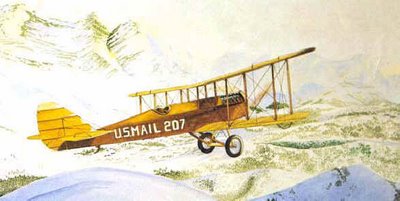 Back in the days between 1907 and 1912, when flying was the Great Experiment, and such pioneer “birdmen” as Hoxsey, Paulhan, and Moisant were making flight history, airplanes were called “crates’’ and ‘‘kites.’’ Certainly they looked the part, flimsy in construction, made of bamboo and ‘‘doped’’ fabric, to which anything might happen any moment, they were aloft. And as for their unpredictable engines—well, the slogan of the day was : “Fly at six—repair all day.’’
Back in the days between 1907 and 1912, when flying was the Great Experiment, and such pioneer “birdmen” as Hoxsey, Paulhan, and Moisant were making flight history, airplanes were called “crates’’ and ‘‘kites.’’ Certainly they looked the part, flimsy in construction, made of bamboo and ‘‘doped’’ fabric, to which anything might happen any moment, they were aloft. And as for their unpredictable engines—well, the slogan of the day was : “Fly at six—repair all day.’’It required real courage to buck the then unknown laws of aeronautics in these fantastic contraptions which were as fragile as kites, for, when something did happen, there was no bailing out in a parachute. The birdman remained in the old crate and took his chances with the inexorable law of gravity in his plunge to earth.
 Most of these intrepid birdmen have long since been forgotten. A few won lasting fame, such as Eugene Ely, who first took off and landed on a boat; Philip Parmelee, Charles Willard, and Louis Paulhan, who revealed the possibilities of the airplane as a military weapon; Lincoln Beachey, the stunt flyer, who could scoop up a handkerchief with a wing tip in much the same manner as a cowboy; and Hoxsey, the gentleman aviator who wore a pince-nez elegantly and was also the undisputed hero of the air during his short career.
Most of these intrepid birdmen have long since been forgotten. A few won lasting fame, such as Eugene Ely, who first took off and landed on a boat; Philip Parmelee, Charles Willard, and Louis Paulhan, who revealed the possibilities of the airplane as a military weapon; Lincoln Beachey, the stunt flyer, who could scoop up a handkerchief with a wing tip in much the same manner as a cowboy; and Hoxsey, the gentleman aviator who wore a pince-nez elegantly and was also the undisputed hero of the air during his short career.  The death-trap crates and their intrepid birdmen are long gone, hut their invaluable accomplishments made possible the foolproof masterpieces of aircraft we have today. Certainly, in the annals of aviation, their historical importance will live forever.
The death-trap crates and their intrepid birdmen are long gone, hut their invaluable accomplishments made possible the foolproof masterpieces of aircraft we have today. Certainly, in the annals of aviation, their historical importance will live forever.(Excerpts from an article by Dr VANCE J. HOYT in Air Trails Magazine, February 1946. For the full story click on Link)
ydcf789vgd
ReplyDeletesupreme outlet
golden goose outlet
golden goose outlet
golden goose outlet
golden goose outlet
golden goose outlet
golden goose outlet
golden goose outlet
golden goose outlet
golden goose outlet